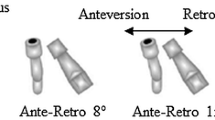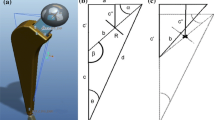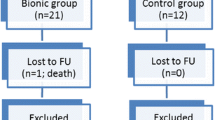Abstract
The restoration of the hip centre of rotation in an anatomical position is considered to be relevant for total hip prosthesis survival. When the cup is implanted with a high centre of rotation, the lever arm of the abductor muscles is decreased, causing higher joint-reaction forces. Modular stems with varying lengths and geometries can be used to balance soft tissues, and ceramic bearing surfaces can be used to reduce the wear rate. Forty-four hip replacements performed with a high hip centre of rotation were matched with 44 performed with an anatomical centre of rotation. In all cases the preoperative diagnosis was dysplasia of the hip (DDH) and cementless modular neck prostheses with ceramic bearing surfaces were used. At nine years follow-up the mean Harris hip and WOMAC scores were not statistically different. All stems and cups were stable; the femoral offset was no different between the two groups (p = 0.4) as leg-length discrepancy (p = 0.25).
Résumé
On considère important pour la survie de la prothèse totale de la hanche que le centre de rotation soit rétabli en position anatomique. Quand le cotyle est implanté avec un centre de rotation haut, le bras de levier des muscles abducteurs se raccourcit et cause des majeures forces de réaction de l’articulation. Les tiges modulaires à longueurs et géométries variables peuvent être utilisés pour balancer les tissus mous, et les couples de frottement en céramique peuvent être utilisés pour réduire l’usure. Quarante-quatre prothèses totales de hanche réalisées avec un centre de rotation haut ont été confrontées avec 44 prothèses réalisées avec un centre de rotation anatomique. Tous les patients souffraient de dysplasie développementale de la hanche et on a utilisé une prothèse sans ciment avec un cou modulaire et avec les couples de frottement en céramique. Les résultats à 9 ans des scores Harris et WOMAC n’étaient pas statistiquement différents. Tous les cotyles et les tiges étaient stables; l’offset fémoral (p = 0,4) et la différence de longueur des membres inférieurs (p = 0,25) n’était pas différents dans les deux groupes.



Similar content being viewed by others
References
Baur W, Honle W, Willert HG et al (2005) Pathological findings in tissue surrounding revised metal/metal articulations. Orthopade 34:225–226, 228–233
Bellamy N, Buchanan WW, Goldsmith CH et al (1988) Validation study of WOMAC: a health status instrument for measuring clinically important patient relevant outcomes to antirheumatic drug therapy in patients with osteoarthritis of the hip or knee. J Rheumatol 15:1833–1840
Bicanic G, Delimar D, Delimar M et al (2008) Influence of the acetabular cup position on hip load during arthroplasty in hip dysplasia. Int Orthop Nov 18 [Epub ahead of print]. doi:10.1007/s00264-008-0683-z
Callaghan JJ, Salvati EA, Pellicci PM et al (1985) Results of revision for mechanical failure after cemented total hip replacement, 1979 to 1982. A two to five-year follow-up. J Bone Joint Surg Am 67:1074–1085
Crowe JF, Mani VJ, Ranawat CS (1979) Total hip replacement in congenital dislocation and dysplasia of the hip. J Bone Joint Surg Am 61:15–23
Dearborn JT, Harris WH (1999) High placement of an acetabular component inserted without cement in a revision total hip arthroplasty. Results after a mean of ten years. J Bone Joint Surg Am 81:469–480
Delp SL, Komattu AV, Wixson RL (1994) Superior displacement of the hip in total joint replacement: effects of prosthetic neck length, neck-stem angle, and anteversion angle on the moment-generating capacity of the muscles. J Orthop Res 12:860–870
Doehring TC, Rubash HE, Shelley FJ et al (1996) Effect of superior and superolateral relocations of the hip center on hip joint forces. An experimental and analytical analysis. J Arthroplasty 11:693–703
Engh CA, Bobyn JD, Glassman AH (1987) Porous-coated hip replacement. The factors governing bone ingrowth, stress shielding, and clinical results. J Bone Joint Surg Br 69:45–55
Hannouche D, Hamadouche M, Nizard R et al (2005) Ceramics in total hip replacement. Clin Orthop Relat Res 430:62–71
Harris WH (1969) Traumatic arthritis of the hip after dislocation and acetabular fractures: treatment by mold arthroplasty. An end-result study using a new method of result evaluation. J Bone Joint Surg Am 51:737–755
Hendricks KJ, Harris WH (2006) High placement of noncemented acetabular components in revision total hip arthroplasty. A concise follow-up, at a minimum of fifteen years, of a previous report. J Bone Joint Surg Am 88:2231–2236
Jerosch J, Steinbeck J, Stechmann J et al (1997) Influence of a high hip center on abductor muscle function. Arch Orthop Trauma Surg 116:385–389
Karachalios T, Hartofilakidis G, Zacharakis N et al (1993) A 12- to 18-year radiographic follow-up study of Charnley low-friction arthroplasty. The role of the center of rotation. Clin Orthop Relat Res 296:140–147
Kobayashi S, Saito N, Nawata M et al (2003) Total hip arthroplasty with bulk femoral head autograft for acetabular reconstruction in developmental dysplasia of the hip. J Bone Joint Surg Am 85:615–621
Korovessis P, Petsinis G, Repanti M et al (2006) Metallosis after contemporary metal-on-metal total hip arthroplasty. Five to nine-year follow-up. J Bone Joint Surg Am 88:1183–1191
Lachiewicz PF, McCaskill B, Inglis A et al (1986) Total hip arthroplasty in juvenile rheumatoid arthritis. Two to eleven-year results. J Bone Joint Surg Am 68:502–508
Mattingly DA (2005) The S-rOM modular femoral stem in dysplasia of the hip. Orthopedics 28:s1069–s1073
Park YS, Moon YW, Lim SJ et al (2005) Early osteolysis following second-generation metal-on-metal hip replacement. J Bone Joint Surg Am 87:1515–1521
Sakai T, Sugano N, Ohzono K et al (2006) The custom femoral component is an effective option for congenital hip dysplasia. Clin Orthop Relat Res 451:146–153
Stans AA, Pagnano MW, Shaughnessy WJ et al (1998) Results of total hip arthroplasty for Crowe type III developmental hip dysplasia. Clin Orthop Relat Res 348:149–157
Toni A, Traina F, Stea S et al (2006) Early diagnosis of ceramic liner fracture. Guidelines based on a twelve-year clinical experience. J Bone Joint Surg Am 88(Suppl 4):55–63
Vasavada AN, Delp SL, Maloney WJ et al (1994) Compensating for changes in muscle length in total hip arthroplasty. Effects on the moment generating capacity of the muscles. Clin Orthop Relat Res 302:121–133
Yoder SA, Brand RA, Pedersen DR et al (1988) Total hip acetabular component position affects component loosening rates. Clin Orthop Relat Res 228:79–87
Author information
Authors and Affiliations
Corresponding author
Rights and permissions
About this article
Cite this article
Traina, F., De Fine, M., Biondi, F. et al. The influence of the centre of rotation on implant survival using a modular stem hip prosthesis. International Orthopaedics (SICOT) 33, 1513–1518 (2009). https://doi.org/10.1007/s00264-008-0710-0
Received:
Revised:
Accepted:
Published:
Issue Date:
DOI: https://doi.org/10.1007/s00264-008-0710-0




